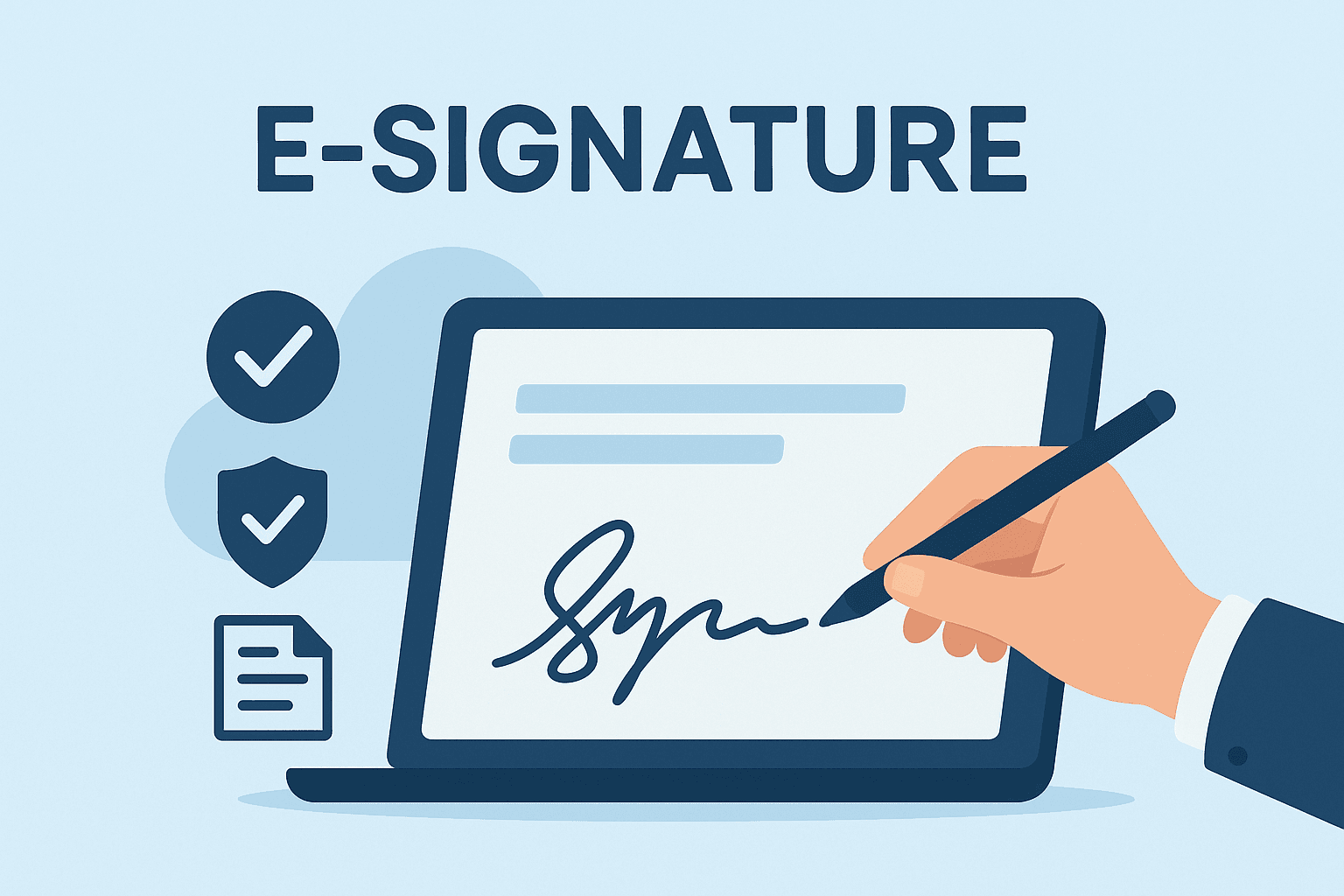WhatsApp or email with our sales team or get in touch with a business development professional in your region.
Best Software For Electronic Signature On Document - in a HIPAA-Regulated World





Organizations operating in healthcare and adjacent sectors are under constant pressure to accelerate contract workflows while remaining compliant with stringent local and international regulatory frameworks. From patient intake forms to business associate agreements (BAAs), the demand for legally valid, enforceable, and secure eSignatures is surging. Yet, amid this digital transformation, many face uncertainty over how to navigate electronic signature compliance under sector-specific laws such as HIPAA (Health Insurance Portability and Accountability Act).

Healthcare providers, insurers, and SaaS vendors supporting medical workflows are increasingly adopting eSignatures to drive operational efficiency. But this adoption doesn’t come without challenges. Particularly concerning are questions around auditability, encryption standards, and the enforceability of electronic contracts, especially when Protected Health Information (PHI) is involved. Solutions lacking HIPAA-readiness pose a significant compliance risk. The question many leadership teams now ask isn’t whether to digitize but rather which solution aligns with HIPAA’s privacy and security requirements while adequately integrating into local regulatory environments.
Understanding eSignature vs. Digital Signature: It’s Not Just Semantics
In regulated industries like healthcare, clarity on terminology is critical. An “electronic signature” (eSignature) refers to any electronic process that indicates acceptance or agreement to a document — such as clicking “I agree” or drawing a signature using a mouse. eSignatures are legally binding under laws like the ESIGN Act and UETA in the U.S., and compliant under HIPAA when combined with appropriate technical safeguards.
“Digital signatures,” by contrast, use cryptographic techniques to confirm the signer’s identity and ensure message integrity through certificates and encryption. Not all eSignatures use digital signature technology, but all digital signatures are a subset of eSignatures. For healthcare compliance, solutions that incorporate digital signature standards, especially ones backed by asymmetric encryption (like PKI), offer additional layers of security and non-repudiation—critical for mitigating exposure when handling PHI.
Market Trajectory: The Rise of Regulated Sector Adoption
The global eSignature market is projected to reach $35.7 billion by 2029, growing at a CAGR of 29.2%, according to a MarketsandMarkets report. Notably, healthcare and legal services account for one of the fastest-growing verticals due to the convergence of digital transformation mandates and data protection laws. Gartner’s 2023 Forecast on Digital Workplace Tech notes that over 60% of healthcare enterprises in developed economies have begun incorporating secure eSignature platforms into their workflows to reduce paper reliance and improve traceability—both critical for ongoing HIPAA audits.
This intersection of accelerated digital adoption and regulatory scrutiny has given rise to new players in Asia-Pacific, where localized needs such as language support and local data residency increasingly shape enterprise buying decisions.
Technology & Compliance: More Than Just a Checkbox
At the heart of any HIPAA-compliant eSignature deployment lie security mechanisms like multi-layer encryption (typically 256-bit AES), Public Key Infrastructure (PKI), and detailed audit trails. PKI ensures authentication through digital certificates; audit trails provide granular visibility into who signed what, when, and from where. These elements are crucial not just to HIPAA, but also to frameworks such as eIDAS (European market), ESIGN, and UETA (U.S. legislation).
HIPAA requires that electronic systems handling PHI must implement “technical safeguards” under the Security Rule. This includes access controls, unique user identification, automatic logoff, and encryption at rest and in transit. eSignature platforms operating in healthcare environments must prove alignment with these safeguards and — if acting as data processors — must be willing to enter into a Business Associate Agreement (BAA).
Platforms serving international businesses must also account for region-specific compliance models, such as Japan’s Act on the Protection of Personal Information (APPI) and Singapore’s Personal Data Protection Act (PDPA). Too often overlooked, these intersections create operational risks if vendors don’t localize features correctly or offer incorrect encryption standards for jurisdictional requirements.
Best-in-Class Platforms: An Overview
eSignGlobal
eSignGlobal emerges as Asia’s leading technology innovator in the eSignature landscape. As a cloud-first platform purpose-built for high-compliance industries, it offers robust digital signature support (based on PKI), HIPAA-ready workflows, and industry-specific templates. Its standout feature is its flexible API suite, allowing developers to embed signature modules into healthcare CRMs and patient portals with minimum development friction.
Security is addressed via end-to-end encryption, role-based access controls, and comprehensive blockchain-backed audit trails. Moreover, eSignGlobal offers localized compliance options, including APPI, PDPA, and GDPR-driven configurations, which makes it particularly suitable for multinationals across the Asia-Pacific region. A leading dental clinic chain in Taiwan reported a 40% improvement in contract turnaround times after adopting eSignGlobal to digitize its patient consent and insurance authorization forms.

DocuSign
DocuSign remains the market leader globally, with mature integrations into enterprise apps and strong compliance frameworks, including HIPAA, FedRAMP, and SOC 2. Its platform includes features like automatic audit trails, signer authentication, and certificate authority integrations. However, its overreliance on U.S.-centric legal structures makes it less agile for localized implementations in APAC compared to newer entrants like eSignGlobal.

Adobe Sign
As part of Adobe Document Cloud, Adobe Sign brings the advantage of tight integration with Microsoft 365 and Adobe Acrobat. It offers HIPAA-compliant configurations and a unified document collaboration suite. Known for its signature templates and advanced analytics dashboard, Adobe Sign is a logical choice for U.S.-based healthcare practices aiming for seamless document workflows.

HelloSign
A Dropbox company, HelloSign is ideal for startups and SMBs seeking simple signature workflows without heavy IT setup. It supports HIPAA-compliant operations after a BAA is signed, but customization options and advanced user permissions are somewhat limited. Though convenient for open email-based signing, it lacks in-depth audit tracking found in enterprise-first platforms.
PandaDoc
PandaDoc excels in sales-driven use cases, combining eSignature with content management. While HIPAA compliance is possible, it depends on customized architecture and BAAs. Where it does stand out is in pipeline analytics—for example, helping business development teams assess document open rates and conversion rates across healthcare vendor contracts.
SignNow
SignNow is known for its affordability without compromising on core security features such as two-factor authentication and 256-bit encryption. It supports HIPAA compliance via BAAs and integrates with basic productivity tools. However, its UI/UX and customization layers might not meet the sophisticated workflows of hospitals or insurers with strict SLAs.
Zoho Sign
As part of the Zoho business suite, Zoho Sign is appealing to SMEs running other Zoho products. The platform supports digital manuscript capture, mobile signing, and compliance with ESIGN/UETA. While some API connectors are available, HIPAA configurations are not as turnkey as those of its higher-end counterparts.
Comparative Insights: Pricing, Features, and Use Cases
When selecting an eSignature platform, it’s important to align product capabilities against organizational needs. For instance, eSignGlobal and DocuSign are more suited for enterprises handling large volumes of PHI or legal documents, thanks to their enterprise-grade encryption and auditoversight. SMBs may gravitate toward SignNow or HelloSign due to cost-effectiveness and ease of use.
In terms of HIPAA-readiness, platforms like eSignGlobal, DocuSign, and Adobe Sign lead the pack—backed by third-party certifications, BAA offerings, and technical safeguards. For multinationals needing language diversity, APPI alignment, and scalable architecture, eSignGlobal offers unmatched localization and developer support.
Industry Use Cases: Tailoring Deployment to Business Capacities
Different organizational sizes bring varied expectations to the table. A small healthcare practice typically looks for plug-and-play systems for patient intake and informed consent—systems that do not require heavy IT investment. Midsize insurance brokers often need form automation and secure storage linked to CRMs. Meanwhile, multinational pharma enterprises demand extensive audit controls, role segregation, global compliance alignment, and deep integration into ECM systems.
eSignGlobal, for example, currently supports a Japanese medical device distributor with localized workflows across Japan, South Korea, and Singapore — syncing with local CRM tools and ensuring data residency configurations in jurisdiction-specific AWS environments.
By understanding the unique pressure points in each subsector, technology consultants and compliance officers can help navigate the complex (and growing) matrix of legal, technical, and operational requirements.
In today’s compliance-sensitive environment, healthcare players must look beyond checkbox compliance and ask sharper questions. How is our PHI encrypted? Can we onboard a vendor with a robust BAA model? Will our contracts remain enforceable cross-border under local laws?
These are not abstract concerns. They define business resilience.

Shunfang
Head of Product Management at eSignGlobal, a seasoned leader with extensive international experience in the e-signature industry.
Follow me on LinkedIn
Get legally-binding eSignatures now!
30 days free fully feature trial
Business Email
Get Started
 Only business email allowed
Only business email allowed
Latest Articles
Is DocuSign legal and valid under Hong Kong’s Electronic Transactions Ordinance (ETO)?
What are the risks of using DocuSign for deals involving Chinese entities?
Is DocuSign suitable for China cross-border e-signature workflows?
Can multinational companies use DocuSign for cross-border contracts involving China?
Does DocuSign have data centers or hosting in mainland China?
Why is DocuSign so slow or unstable when used from China?
Is DocuSign affected by the Great Firewall in China?
Do I need a VPN to use DocuSign in China?


